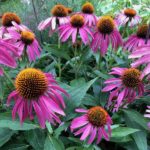Garden Mandala Creation

The plant designs in the photos were created as part of a mindfulness garden games workshop I led on July 12th at the National Children and Youth Garden Symposium here in Denver (It was sponsored by the American Horticultural Society.) The designs are a type of mandala, a centering device used in traditional meditation. There is a focal point that draws the eyes repeatedly back to the center, facilitating attentiveness. Our workshop focused on the creation of the design as a mindfulness practice.
Teams of five created each design using lots of interesting plant materials harvested from my yard. Participants worked in silence (with quiet flute music playing), directing their attention to mindfulness. This meant breathing fully; choosing plant materials deliberately; walking attentively back to their design area; observing the design to see where others were placing their materials; and then thoughtfully adding their plants to the design.

You can of course do this activity solo, but the synergy and connection doing a group mandala is palpable. Because of workshop time constraints, the creation of the mandalas was only a ten minute exercise. Yet, even in that brief time, a shift of energy happened in the room, which I think was surprising for many of the participants.
A Shift in Energy and Focus
How can a shift to calmness and connection happen in such a short time? Slowing down for a few moments and focusing on just one task can be very powerful. And this particular task involves green materials which have an energy and power of their own.

Plants engage our senses with fragrance and touch. When we are silent we can tune into those other senses more fully. Using plants in designs in this way allows us to really be aware of the leaf, flower, or stem in our hand. We move from thinking about function and analysis (i.e. what is this, is it edible, why is it this color) to being fully attentive to the form in front of us.
There is also a fascinating process of watching the design unfold in front of our eyes. As in life, we each play a part, but we are not in control of the entire design. And remaining silent means we cannot negotiate with anyone about where certain plants should be placed. It just happens one moment to the next. We are attentive to it; and then find our place within the greater design.

Like all mindfulness activities, creating mandalas must be experienced and not just read about. So head outside and gather up some plant materials to create your own mandala. The most plentiful materials are often plants that are considered weeds. If you look closely at our mandalas you’ll see dandelion, burdock, yellow dock, and Siberian elm along with more traditional garden plants. Allow yourself to be thankful for all those weeds you can now include as part of your mindfulness practice.


